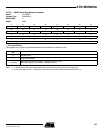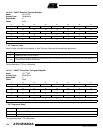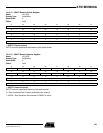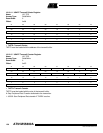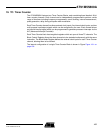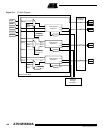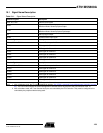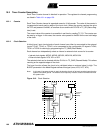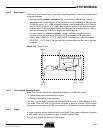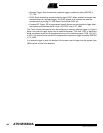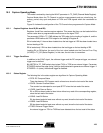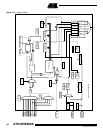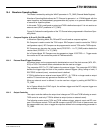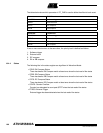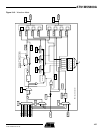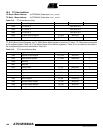
161
1745D–ATARM–04-Nov-05
AT91M55800A
19.2.3 Clock Control
The clock of each counter can be controlled in two different ways: it can be enabled/disabled
and started/stopped.
• The clock can be enabled or disabled by the user with the CLKEN and the CLKDIS
commands in the Control Register. In Capture Mode it can be disabled by an RB load event
if LDBDIS is set to 1 in TC_CMR. In Waveform Mode, it can be disabled by an RC Compare
event if CPCDIS is set to 1 in TC_CMR. When disabled, the start or the stop actions have
no effect: only a CLKEN command in the Control Register can re-enable the clock. When
the clock is enabled, the CLKSTA bit is set in the Status Register.
• The clock can also be started or stopped: a trigger (software, synchro, external or
compare) always starts the clock. The clock can be stopped by an RB load event in
Capture Mode (LDBSTOP = 1 in TC_CMR) or a RC compare event in Waveform Mode
(CPCSTOP = 1 in TC_CMR). The start and the stop commands have effect only if the clock
is enabled.
Figure 19-3. Clock Control
19.2.4 Timer Counter Operating Modes
Each Timer Counter channel can independently operate in two different modes:
• Capture Mode allows measurement on signals
• Waveform Mode allows wave generation
The Timer Counter Mode is programmed with the WAVE bit in the TC Mode Register. In Cap-
ture Mode, TIOA and TIOB are configured as inputs. In Waveform Mode, TIOA is always
configured to be an output and TIOB is an output if it is not selected to be the external trigger.
19.2.5 Trigger
A trigger resets the counter and starts the counter clock. Three types of triggers are common
to both modes, and a fourth external trigger is available to each mode.
The following triggers are common to both modes:
QS
R
S
R
Q
CLKSTA CLKEN CLKDIS
Stop
Event
Disable
Event
Counter
Clock
Selected
Clock
Trigger



